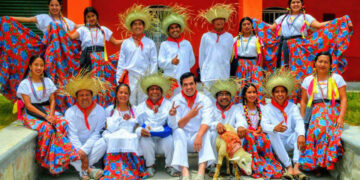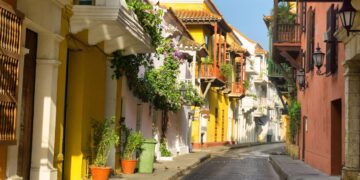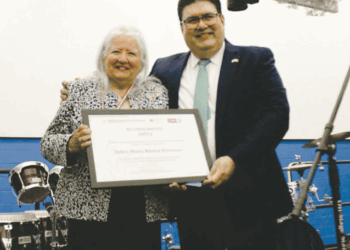In recent years I have increasingly approached Ray Lozano, Executive Director for the Mexicantown Community Development Corporation (MCDC), for program support and use of their facilities on Bagley in the shadow of the Ambassador Bridge and within walking distance from the Michigan Central Train Station. Without exception he has been extremely supportive of my efforts to program cultural, educational and diversity awareness activities. I am not the only one that has been able to count on that support. As a result, the center through its Latino Cultural Center/Art Gallery located on the first floor, has become home to numerous community gatherings from art exhibits, concerts, poetry sessions, Dia de los Muertos ofrendas, among many others.
In addition, the facility has hosted a significant number of outside organizations to put on outreach activities for Southwest Detroit residents. Organizations such as the Detroit Historical Designation Board, Aetna Medicare Solutions, Credit Union One, Michigan Humane Society, Wayne State University, Southwest Holiday Fest Committee, Councilmember Gabriela Santiago-Romero for District 6, PNC, Detroit Symphony Orchestra, The District Detroit, Olympia Development, Martin H. Solis Jr. Tejano Association, Comite Patriotico Mexicano de Detroit, El Consulado de Mexico en Detroit among many others have utilized the facilities. Thus, it is no exaggeration to say the MCDC has become a major force within our community in keeping with Ray’s long-standing wish to make the center a destination point for the city.
I met with Ray recently to get a better understanding of his family’s history and his community involvement over the decades. In 1916 Ray Lozano’s grandfather landed a contract with the Bay City Sugar Beet Company to pick sugar beets. He was a member of an extended family that left Aguascalientes Mexico and crossed over to El Paso. The extended family went to Denver where conditions were rough, many essentially sleeping in box cars. Thus, they moved to Chicago, while half of them later moved to Detroit. Of those who came to Detroit some settled near Belle Isle while others on 11th Street in the Corktown neighborhood.

His parents married in 1925. Ray has three brothers and one sister and he was the only one born in Detroit. The rest were born in Chicago as his parents would travel frequently between Detroit and Chicago.
He and his sister went to St Anthony School, at that time located on the corner of 25th and Vernor which was mainly Lithuanian with few Mexicans attending. He would move on to Holy Redeemer while his older siblings went to Western High.
Upon graduation he attended Henry Ford Community College before being drafted in 1967. This would lead to being stationed to Fort Knox for basic training and later Fort Polk, Louisiana. He would return to Fort Knox and there served as a vehicle commander. Upon being sent to Vietnam he was part of the 1st Air Cavalry Unit and ended up with the 173rd Airborne Brigade. His unit cleared roads in the jungle. He served a total of six years in the military – two tears in active duty and four years as a reservist. From January ’68 to January ’69 while in Vietnam he spent was assigned to a helicopter landing zone.
Upon his return to Detroit in January 1969 he began studies at Wayne State University. In 1974 he graduated with a Special Education degree which would play a key role in his life of community service. With that degree he started volunteering at Latin Americans for Social and Economic Development (LA SED)with children in the developmental disabilities’ unit. It was during that period LA SED pursued two lawsuits that successfully challenged the educational practice of that time which improperly channeled Spanish speaking children into “special ed” tracks, thus effectively denying them instruction. Margarita Sotomayor-Roxbury and he approached attorney Gabe Kaimowitz and sued the Detroit Board of Education with Ray as the plaintiff in “Lozano vs Detroit Board of Education”. The demand was for bilingual psychologists and bilingual education. Detroit history was changed because of that.
Ray has worked in a range of business and non-profit settings. It was during his time at LA SED he met a number of other Latino leaders and embarked on his own journey of community leadership. He would serve as the agency’s Executive Director from 1978-80. During this time, he secured LA SED’s first Detroit Area on Agency grant for their Senior Citizen’s program on W. Vernor across from Clark Park, in what is now Mexicantown Bakery.
Upon leaving LA SED in 1980, he went to work at Michigan Consolidated Gas (MichCon) as Manager of Statewide Community Relations and Local Government Affairs, primarily responsible for western and southern Wayne County. He spent twenty-one years with the gas company and four with Detroit Edison as Manager of Ethnic Marketing. Prior to their merger into what we now know as DTE Energy, they were two separate utility companies. He is proud of the fact that during his tenure he was responsible for promoting diversity within the then all-white male public affairs unit and hired the first African Americans, one who was also the unit’s first woman. He would retire in 2005, assuming the position of Executive Director of the Michigan Hispanic Chamber of Commerce. He remained at that position for five years from 2005 to 2010. If you recall from 2008 to 2010 the economy was in dire straits and the agency also suffered some lean years because of it.
Ray Lozano moved to New Detroit in 2010 where he served as the Director of Race Relations during a time when the agency was increasing its multicultural and multiracial coalition-building efforts. He remained in that position until 2015.

From 2015 to 2017 he worked at Michigan Veterans Foundation where he provided case management, housing and other services. When in 2017 the position of Executive Director for the Mexicantown Community Development Corporation (MCDC) opened, he successfully applied. In a matter of a couple of years the nation was challenged by the COVID-19 pandemic yet Ray and his team managed to carve out a special place for the organization. Founded in 1989, MCDC became a leader in the revitalization of Southwest Detroit when in 2007 they developed the $17.5 M Welcome Center and Mercado buildings and outdoor plaza. Originally set up to “train community residents in entrepreneurship to revitalize economic ownership of community businesses and empowerment of community residents that had been severed with the construction of the I-75 freeway in the early 1960s.”, Ray often says MCDC’s current work “follows its original vision with a modern-day lens”, highlighting the interplay between arts, business and culture.
When asked to reflect on what motivates him, he credits the influence of a number of people and organizations he has worked with over the years on a local and national level. These include, among others, the National GI Forum, the Labor Council for Latin American Advancement (LCLAA) and the Coalition of Spanish-Speaking Mental Health Organizations (COSSMHO), now known as National Alliance for Hispanic Health. He was also a board member of ACCESS, the nation’s premier human services organization serving the Arab American community. He has a strong belief in working with and in “cross fertilization” with other communities. This work continues to date with his ongoing work with the former CEO of ACCESS, Ishmael Ahmed through the Cultural Exchange Network (CEN) and the Concert of Colors, one of the country’s largest free world music festivals. He also served as President of the Comite Patriotico Mexicano de Detroit and is proud of the fact they were able to keep the Parade and Fiesta going virtually during the COVID pandemic.
For five years he was the Chair of the National Council of La Raza (NCLR), now known as UnidosUS and in that capacity was part of the team that hired its current CEO Janet Murguia. During President’s Obama administration, he was appointed to the Community Advisory Board for the nation’s Environmental Protection Agency (EPA). During his six-year term he chaired the international section, which led to travels to the Canadian Northwest Territory where forest fires were raging at the time, also to Toronto, Montreal, in addition to locales throughout the US. He traveled twice to New Orleans’ Ninth Ward seeing first-hand the devastation of Hurricane Katrina.
As I watch Ray in action now, I am amazed at his boundless level of energy. When most folks would gladly be retired, he sees that he has much more to do. For that we are all the beneficiaries of his lifetime of work.














































